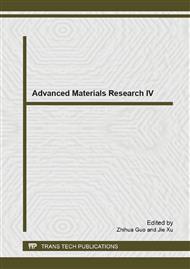p.311
p.316
p.323
p.328
p.332
p.336
p.342
p.349
p.355
Preparate and Properties on Rare Earth PVA Complex Nanofibers
Abstract:
Nanofiber is an important part in nanomaterials research field, and the polymer nanofibers is one of the important research directions. RE, which has unique electronic structure, the optical, electrical and magnetic aspects of the special nature, combine with the polymer, that has rich raw materials, simple synthesis method, easy processing, high impact resistance, light weight and low cost advantages, to get a new kind materials of practical uses and potential applications. This topic was prepared PVA/Sm (NO3)3 composite nanofibers using an electrostatic spinning, and the PVA/Sm (NO3)3 nanofibers were treated at an appropriate temperature to obtain Sm2O3 nanofibers. Samples were characterized and analyzed by the SEM, FTIR, XRD, TG-DTA and other modern means. The results show that the surface of PVA/Sm (NO3)3 composite fibers is smooth, uniform size and amorphous. Sm (NO3)3 is not interact with the PVA groups, and the diameter of fiber is 200nm. After firing, the diameter of fibers was reduced to 100nm. PVA, Sm (NO3)3 and the water are completely decomposed at 600°C or more, finally obtained Sm2O3 nanofibers of single-phase crystalline state.
Info:
Periodical:
Pages:
332-335
Citation:
Online since:
February 2014
Authors:
Keywords:
Price:
Сopyright:
© 2014 Trans Tech Publications Ltd. All Rights Reserved
Share:
Citation:


